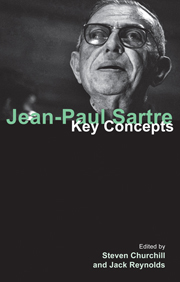Book contents
- Frontmatter
- Contents
- Contributors
- Acknowledgements
- Note on abbreviations
- 1 Introduction: Sartre vivant
- 2 Life and works
- Part I PSYCHOLOGY, PSYCHOANALYSIS AND LITERATURE
- 3 Sartre and Husserl's Ideen: phenomenology and imagination
- 4 Sartre's understanding of the self
- 5 Contingency and ego, intentionality and nausea
- 6 Sartre: novelist and playwright
- 7 Psychoanalysis and existential psychoanalysis
- Part II ONTOLOGY: FREEDOM, AUTHENTICITY AND SELF-CREATION
- Part III ETHICS AND POLITICS
- Bibliography
- Index
5 - Contingency and ego, intentionality and nausea
from Part I - PSYCHOLOGY, PSYCHOANALYSIS AND LITERATURE
- Frontmatter
- Contents
- Contributors
- Acknowledgements
- Note on abbreviations
- 1 Introduction: Sartre vivant
- 2 Life and works
- Part I PSYCHOLOGY, PSYCHOANALYSIS AND LITERATURE
- 3 Sartre and Husserl's Ideen: phenomenology and imagination
- 4 Sartre's understanding of the self
- 5 Contingency and ego, intentionality and nausea
- 6 Sartre: novelist and playwright
- 7 Psychoanalysis and existential psychoanalysis
- Part II ONTOLOGY: FREEDOM, AUTHENTICITY AND SELF-CREATION
- Part III ETHICS AND POLITICS
- Bibliography
- Index
Summary
The first procedure of a philosophy ought to be to expel things from consciousness and to re-establish its true connection with the world.
(BN1: xxvii; BN2: 7)Being is without reason, without cause, and without necessity;
the very definition of being releases to us its original contingency.
(BN1: 619; BN2: 639)A man alone, tête-à-tête with the world
The early period of Jean-Paul Sartre's career is often characterized in terms of his devotion to the pursuit of his literary art, along with the development of his nascent philosophy. The typical imagery associated with the young Sartre of the early 1930s, up until the outbreak of the Second World War, is therefore that of a relatively solitary writer; we might well picture him busily filling the sheets of paper in front of him with the prose flowing swiftly from his pen in a café or a bar, largely oblivious to the goings-on around him. Indeed, Sartre arguably cemented this view of himself, by describing his self-image during this period as that of “a man alone” (Sartre 1977a: 45).
By contrast, the post-war imagery commonly associated with Sartre is that of the “engaged writer”, using his words as a means of commenting on – and indeed actively fighting for – the social and political causes of his day. Accordingly, Sartre’s life and works are often divided in half, with literature trumping politics on one side of the pre-war/post-war divide, and literature serving as a vehicle for political engagement on the other.
- Type
- Chapter
- Information
- Jean-Paul SartreKey Concepts, pp. 44 - 65Publisher: Acumen PublishingPrint publication year: 2013

